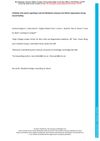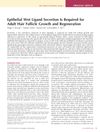Signaling Underlying Wound Healing
September 2019
in “
Encyclopedia of Life Sciences
”
TLDR Wound healing involves complex signaling that stops bleeding, reduces damage, and repairs skin, sometimes without scarring.
The document discussed the complex process of wound healing, emphasizing the integration of various organ systems such as the blood, vasculature, somatosensory, immune system, and skin. It highlighted the role of blood coagulation, driven by tissue factor exposure and thrombin activation, in forming clots and initiating cell signaling. The immune response, involving mast cells and macrophages, was crucial for inflammation and pain signaling, which protected the wound. Sensory neurons became hypersensitive due to inflammatory factors, leading to hyperalgesia. Stem cells from the dermis and hair follicles played a role in wound remodeling, with Wnt and TGF-β signaling pathways balancing regenerative and healing processes. Wnt signaling promoted cell proliferation and hair follicle reappearance, aiding scarless healing, while TGF-β signaling led to scar formation through myofibroblast differentiation.






